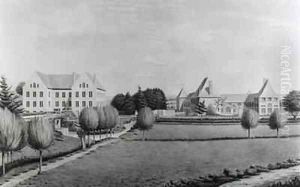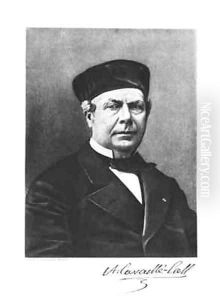F. Dujardin Paintings
F. Dujardin, more commonly known as Karel Dujardin, was a Dutch painter, draughtsman, and etcher born in Amsterdam in 1637. Dujardin was a versatile artist, known for his contributions to the Dutch Golden Age of painting. He was particularly celebrated for his pastoral landscapes, Italianate scenes, and animal paintings, as well as for his genre scenes and portraits. His work often depicted serene, idyllic landscapes infused with a warm, golden light, showcasing his mastery in capturing the delicate interplay between light and shadow, a testament to the influence of the Italian countryside, which he visited during his travels.
Dujardin's early life and training are not thoroughly documented, but he is believed to have been a pupil of Nicolaes Berchem, another prominent Dutch artist of the time, who was known for his Italianate landscapes. This mentorship is evident in Dujardin's work, which often reflected the Italian landscape's influence, despite the artist's Northern European roots. In 1657, Dujardin became a member of the painters' guild in The Hague, and later, his career took him to Italy, where he spent several years. These years were crucial in shaping his style, imbued with the warm hues and classical composition of Italian art and landscape.
Throughout his career, Dujardin also showed a keen interest in depicting animals, particularly livestock, within his landscapes. His animal scenes are remarkable for their realism and attention to detail, attributes that garnered him considerable praise during his lifetime. Besides landscapes and animal scenes, Dujardin produced a number of genre scenes, portraits, and religious subjects, displaying his versatility as an artist. His genre scenes often depicted everyday life with a sense of intimacy and warmth, revealing his acute observation of human and animal subjects alike.
Dujardin's contributions to art were not limited to painting; he was also a skilled etcher, producing works that captured the essence of his paintings in the intricate detail characteristic of the etching medium. His etchings contributed to the spread of his fame beyond the borders of the Netherlands, making him one of the more internationally recognized Dutch artists of his time.
Karel Dujardin died in Venice in 1681, leaving behind a body of work that continued to influence artists long after his death. His paintings and etchings remain highly valued for their technical skill, compositional beauty, and the serene, idyllic quality that characterizes much of his work. Dujardin's legacy is that of an artist who beautifully bridged the worlds of Dutch and Italian art, bringing a unique perspective to the Dutch Golden Age that continues to be celebrated today.

